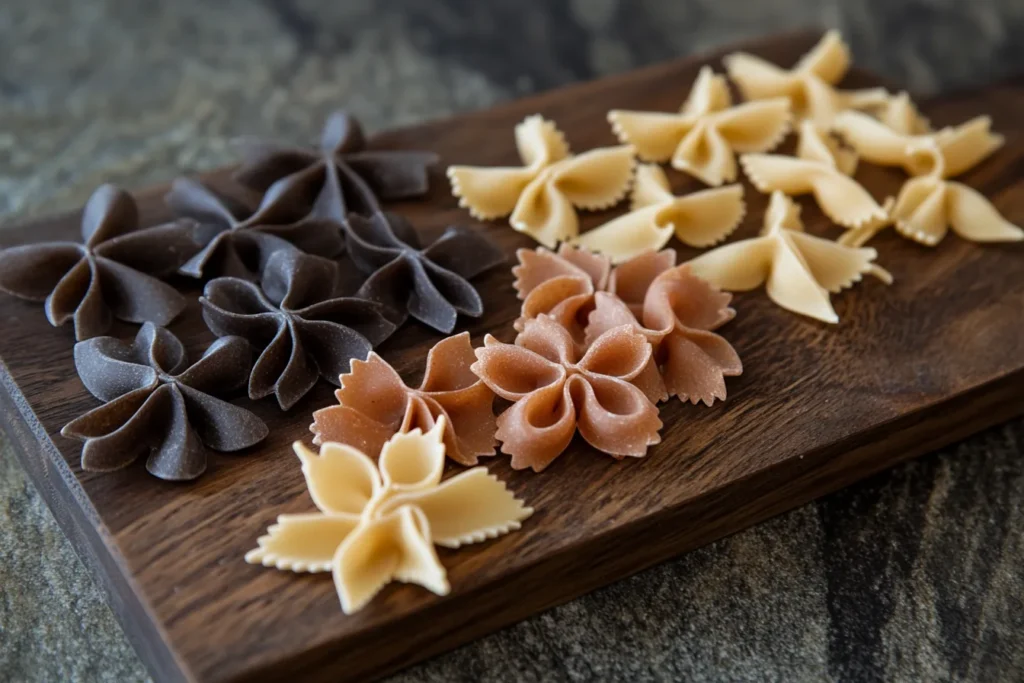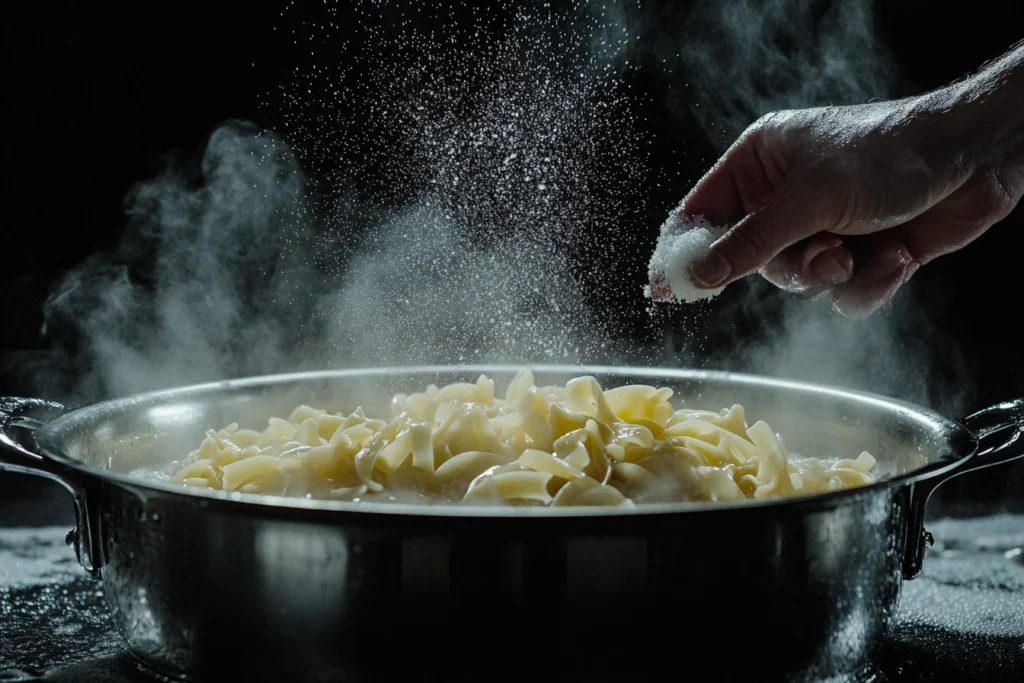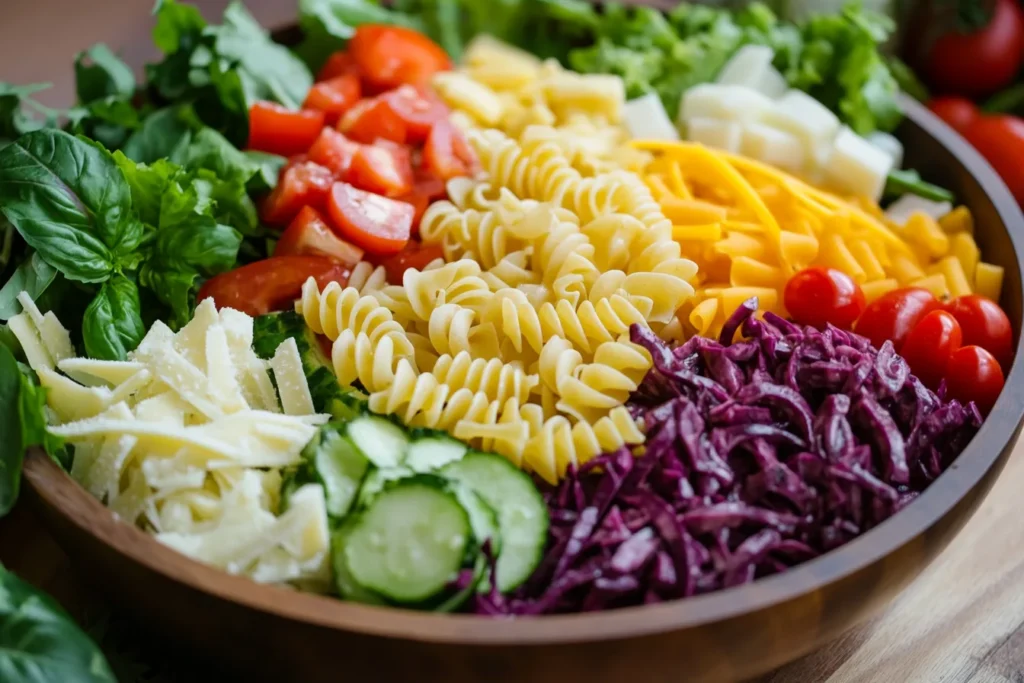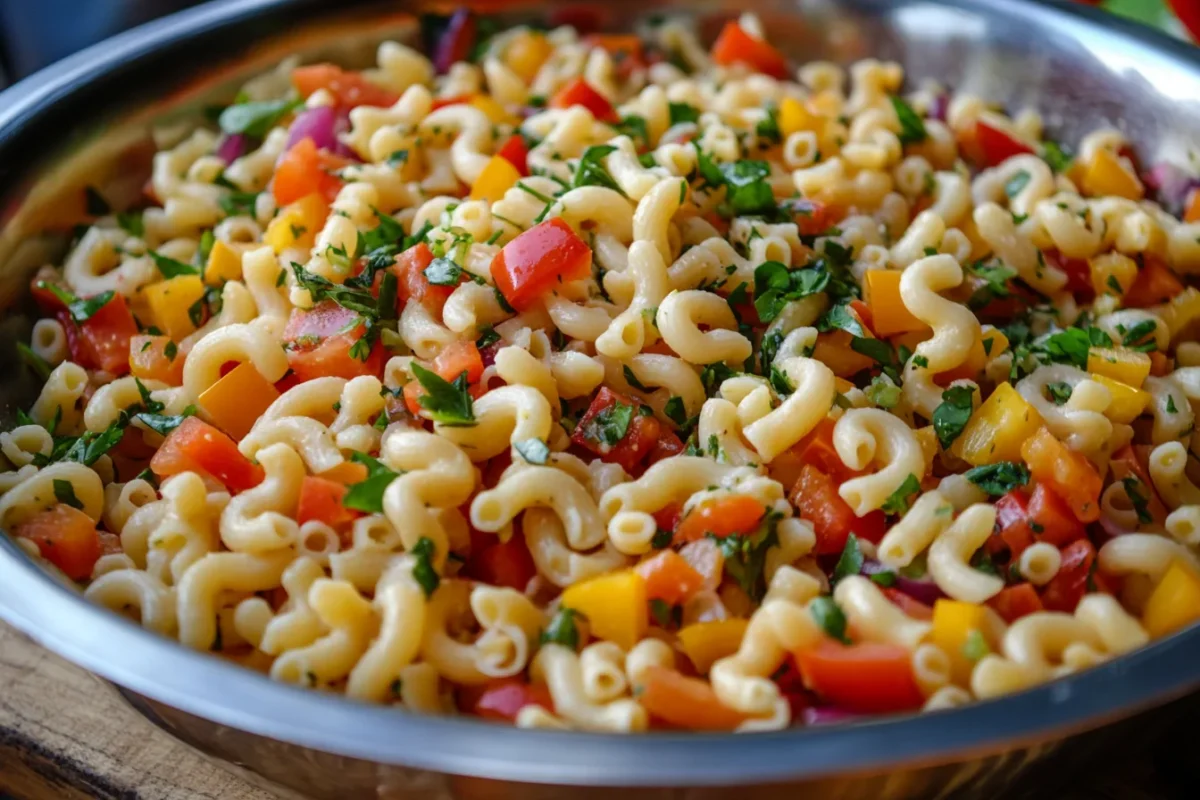What Are the Five Mistakes to Avoid in Pasta Salad?
Introduction
What are the five mistakes to avoid pasta salad? This classic dish, adored for its versatility and ease, might seem foolproof, but plenty of things can go wrong. From mushy pasta to bland dressing, the little details matter.
This article dives into the five most common mistakes to avoid when making pasta salad and provides actionable tips to elevate your dish from ordinary to extraordinary. Whether you’re prepping for a summer BBQ, a picnic, or a quick weeknight dinner, knowing what mistakes to avoid will ensure your pasta salad is a hit every time.
By understanding what are the five mistakes to avoid pasta salad, you’ll prevent common pitfalls like overcooked pasta, lackluster seasoning, and improper ingredient combinations. Keep reading to discover how to perfect your pasta salad and impress your guests!
Common Mistakes in Pasta Salad Preparation
Using the Wrong Pasta Shape
Choosing the wrong type of pasta is one of the biggest pitfalls in pasta salad preparation. While it might be tempting to grab any pasta from your pantry, the shape and texture can make or break your dish. Pasta with smooth surfaces, such as spaghetti or linguine, doesn’t hold onto dressings and ingredients effectively. Instead, opt for short pasta shapes like rotini, fusilli, or farfalle—each groove and fold is perfect for soaking up flavor.
Impact on Texture and Flavor
Why does the texture matter so much? Well, smooth pasta tends to become slippery when mixed with dressing, causing ingredients to slide off. This can lead to a salad that feels disjointed, with bites of plain pasta unaccompanied by vegetables or dressing. By choosing a ridged or textured pasta, you ensure a cohesive bite every time.
Recommended Pasta Shapes for Salads
So, what are the top pasta shapes for salads? Here’s a quick list:
- Rotini: Its spirals trap dressing and herbs beautifully.
- Farfalle (Bowties): Adds a fun shape while maintaining sturdiness.
- Orecchiette: These “little ears” cradle small add-ins like peas or crumbled cheese.
- Penne Rigate: The ridges on this tubular pasta grip dressing perfectly.
To ensure success, stick with these tried-and-true shapes and always check the package directions for the ideal cooking time to maintain the right texture.

Overcooking or Undercooking the Pasta
Achieving Al Dente Perfection
Cooking pasta to the perfect texture is a crucial step in creating a memorable pasta salad. Overcooked pasta turns mushy and unpleasant, while undercooked pasta stays chewy and hard, leaving the dish lacking in balance. The key lies in mastering the art of al dente, which translates to “to the tooth” in Italian. It refers to pasta that is firm but tender enough to bite into without resistance.
To get this right, always follow the cooking time indicated on the pasta package, but start checking for doneness a minute or two earlier. Pasta continues to cook slightly as it cools, especially if it’s tossed with warm ingredients. To stop the cooking process immediately, drain the pasta and rinse it under cold water—a step many overlook when preparing pasta salad.
Effects of Improper Cooking on Salad Quality
Why is the cooking process so critical? Overcooked pasta absorbs too much dressing, leaving the salad soggy and bland. On the other hand, undercooked pasta can overpower the delicate balance of flavors in your salad, as its raw starchiness remains intact. Either way, the result is a pasta salad that feels incomplete.
For a flawless finish:
- Cook pasta in generously salted water (it should taste like the sea).
- Test a piece of pasta for doneness about a minute before the recommended cooking time.
- Rinse the cooked pasta under cold water to cool it down quickly and stop the cooking process.
This small effort ensures your pasta is neither overdone nor underwhelming, creating the ideal foundation for a salad that everyone will love.
Not Seasoning the Pasta Adequately
Importance of Seasoning Pasta Water
One of the most common mistakes when making pasta salad is skipping the critical step of seasoning the cooking water. Pasta itself is relatively bland, and once it’s cooked, there’s no way to infuse it with flavor. By adding salt to the water—enough so that it tastes slightly salty, like the sea—you’re ensuring that each piece of pasta is seasoned from the inside out.
Why does this matter? When the pasta is well-seasoned, it creates a flavorful base that enhances the overall taste of your salad. No matter how rich or complex your dressing is, unseasoned pasta will make the dish taste flat.
A good rule of thumb: Use about 1-2 tablespoons of salt for every 4-5 quarts of water. Don’t worry about the pasta absorbing too much salt; it only takes in a small amount during the cooking process.

Balancing Flavors in the Salad
Seasoning doesn’t stop at the pasta water. Many home cooks fail to taste and adjust the flavors of their pasta salad once it’s assembled. This leads to bland or overpowering bites instead of a balanced medley of flavors.
To avoid this, follow these tips:
- Taste your salad after mixing in the dressing and adjust with a pinch of salt, a squeeze of lemon, or a dash of vinegar as needed.
- Allow the salad to sit for at least 15-20 minutes after dressing it. This resting time lets the flavors meld and deepen, making the dish more cohesive.
- Layer your seasoning! Add a touch of salt and pepper to individual ingredients like vegetables, cheese, or proteins before tossing them together.
Proper seasoning transforms your pasta salad from ordinary to exceptional. It ensures every bite is flavorful, making this step one of the easiest yet most effective ways to elevate your dish.
Using Inappropriate Dressing Techniques
Timing of Dressing Application
Believe it or not, when you dress your pasta salad can make or break its overall quality. Many people make the mistake of adding dressing either too early or too late, leading to disappointing results. The timing affects how the dressing interacts with the pasta and other ingredients, ultimately shaping the salad’s flavor and texture.
For best results, dress your pasta while it’s still slightly warm. Warm pasta absorbs the dressing better, allowing each piece to soak in the flavors. This creates a salad that feels cohesive and well-seasoned, instead of one where the dressing pools at the bottom of the bowl.
However, don’t go overboard and dress it while it’s piping hot. Dressing applied to hot pasta can break down delicate ingredients like herbs or greens, leaving them wilted and unappetizing. The sweet spot is when the pasta is just warm to the touch but no longer steaming.
Quantity and Type of Dressing
Another misstep is using too much or too little dressing. Overdressing results in a soggy, overpowering salad, while underdressing makes it dry and unappetizing. Striking the right balance is crucial.
Start by adding a small amount of dressing and toss thoroughly. Remember, you can always add more, but you can’t take it away. After mixing, taste and adjust as needed. If your pasta salad is sitting in the fridge for an extended period, consider reserving a bit of dressing to freshen it up just before serving.
Equally important is the type of dressing you choose. Creamy dressings like mayonnaise or Greek yogurt bring richness but can feel heavy if overused. On the other hand, oil-based dressings, like vinaigrettes, lend a lighter, fresher feel to the salad. For a foolproof option, a lemon-herb vinaigrette works beautifully—it’s flavorful without overwhelming the dish.
Improper Ingredient Balance and Preparation
Proportion of Ingredients
One of the most overlooked aspects of a great pasta salad is maintaining a proper balance between the pasta and other ingredients. A common mistake is overloading the dish with pasta, leaving it one-dimensional and bland. On the flip side, adding too many mix-ins can overwhelm the salad, masking the pasta’s role as the star of the show.
For a well-balanced pasta salad, aim for a ratio of about 60% pasta to 40% other ingredients. This ensures that every bite includes a delightful mix of textures and flavors. Strive for variety—crisp vegetables, creamy cheeses, and savory proteins all have their place, but don’t go overboard. Too many competing elements can create a chaotic dish instead of a harmonious one.
When planning your ingredients, consider the following:
- Vegetables: Crunchy options like bell peppers, cucumbers, or cherry tomatoes add freshness and color.
- Proteins: Grilled chicken, shrimp, or chickpeas bring heartiness.
- Cheese: Feta, mozzarella, or Parmesan add creaminess and a touch of saltiness.
- Herbs and Spices: Basil, parsley, or oregano elevate the dish with fresh, aromatic notes.
Preparing Ingredients for Optimal Texture
Even when you’ve nailed the right ingredient proportions, preparation matters. Ingredients that are too large, improperly cooked, or poorly chopped can ruin the salad’s appeal.
Here are a few preparation tips:
- Dice vegetables uniformly to ensure even distribution and prevent certain bites from feeling overly loaded.
- Cook proteins correctly—nothing is worse than overcooked chicken or rubbery shrimp ruining your carefully crafted dish.
- Dry leafy greens thoroughly to prevent them from watering down the salad.
- Toast nuts or seeds (if using) to enhance their flavor and crunch.
Remember, the key to a perfect pasta salad lies in ensuring that all ingredients work together seamlessly, providing a variety of textures and flavors in each bite.
Enhancing Your Pasta Salad
Selecting Fresh and Quality Ingredients

A pasta salad is only as good as the ingredients you use. Freshness is non-negotiable if you want to achieve a dish bursting with flavor. Using crisp vegetables, ripe tomatoes, and high-quality oils can elevate your pasta salad from good to exceptional.
- Vegetables: Look for vibrant, firm vegetables like bell peppers, cucumbers, and red onions. Avoid wilted or overly soft produce.
- Cheese: Opt for fresh mozzarella or crumbled feta over pre-shredded varieties for a creamier texture and richer flavor.
- Dressing Ingredients: Use extra virgin olive oil, freshly squeezed lemon juice, and high-quality vinegar for a dressing that shines.
By prioritizing freshness, you’ll create a pasta salad that feels vibrant and inviting.
Incorporating Herbs and Spices
Adding fresh herbs and spices is an easy yet effective way to give your pasta salad a flavor boost. Herbs like basil, parsley, cilantro, or dill bring an earthy, aromatic element, while spices can add depth and character.
For example:
- Use basil for a classic Italian flair.
- Add a pinch of cumin or paprika for subtle warmth.
- Sprinkle crushed red pepper flakes if you want a bit of heat.
Don’t forget to season thoughtfully. A light hand with salt and pepper goes a long way in bringing the flavors together without overpowering the dish.
Creative Add-ins for Texture and Flavor
Sometimes, it’s the little extras that make a pasta salad unforgettable. Adding unexpected ingredients can enhance the texture and flavor, making your dish stand out. Consider incorporating:
- Crunchy Elements: Toasted nuts, seeds, or croutons.
- Sweet Touches: Dried cranberries, chopped apples, or a drizzle of honey in the dressing.
- Savory Umami: Sun-dried tomatoes, olives, or capers.
By using these add-ins sparingly, you can surprise and delight your guests without overwhelming the core flavors of your pasta salad.
Conclusion
Recap of Key Points
Crafting the perfect pasta salad is as much an art as it is a science. By avoiding the five common mistakes—choosing the wrong pasta shape, overcooking or undercooking the pasta, neglecting to season properly, mishandling dressing techniques, and failing to balance ingredients—you can transform a simple dish into a culinary masterpiece.
Equally important is enhancing your salad with fresh, high-quality ingredients, thoughtfully chosen herbs and spices, and creative add-ins. These steps ensure your pasta salad not only looks vibrant but also delivers a medley of flavors and textures in every bite.
Encouragement to Experiment and Enjoy
Remember, pasta salad is incredibly versatile—there’s no one-size-fits-all recipe. Don’t hesitate to experiment with your favorite ingredients or try new combinations. Whether you’re preparing it for a family gathering, a picnic, or a quick weeknight meal, your pasta salad can be a true crowd-pleaser when made with care and attention to detail.
By following these tips, you’re well on your way to mastering the art of pasta salad. Now, it’s time to grab a bowl and start tossing your way to perfection. Enjoy!

